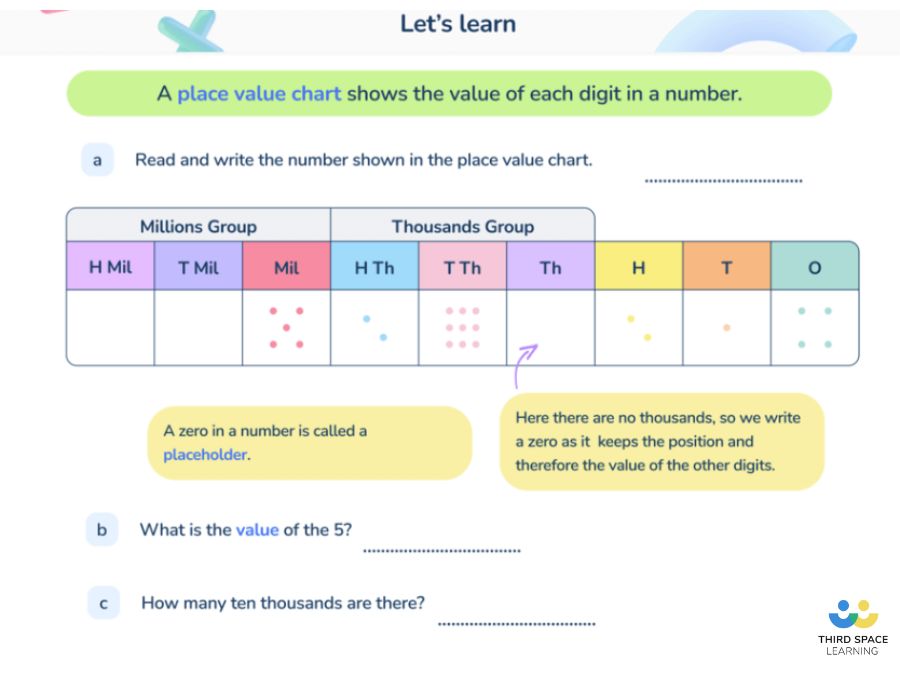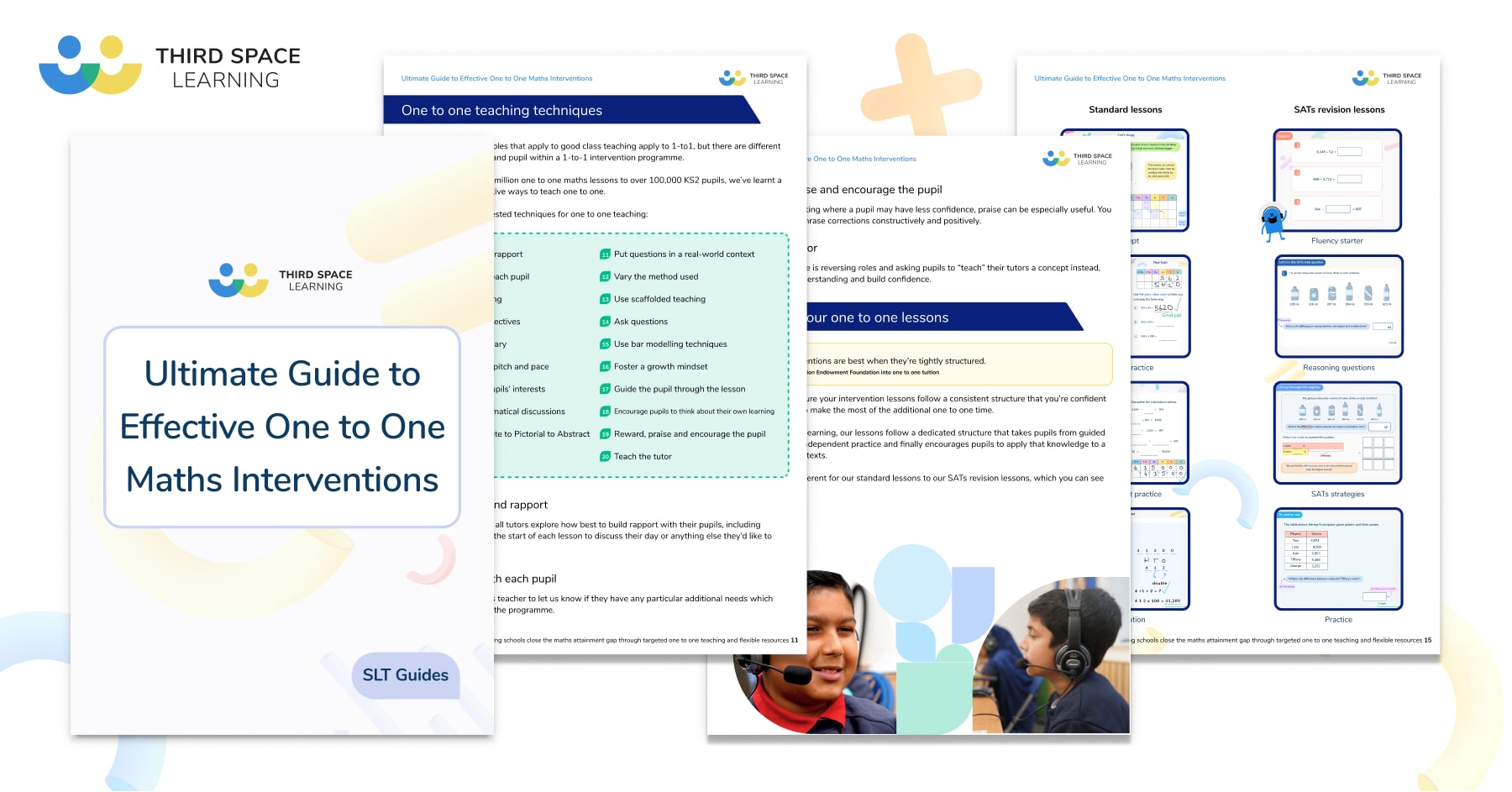7 Intervention Myths That Are Limiting The Progress Your Pupils Could Make In Maths
As the largest provider of primary one to one maths interventions for Year 6, we speak to hundreds of schools each week about making significant improvements in maths outcomes for their pupils.
Each school’s unique circumstances and communities brings with it their own sets of challenges and questions around what works in maths teaching and interventions.
But with that also come some really quite common misconceptions and even myths around interventions in school.
Here we take a look at some of these misconceptions as we tackle the 7 biggest maths intervention myths we hear. We end with a summary of the actual research around maths interventions, specifically those that work one to one so you can be better informed the next time you’re looking for a primary school intervention.
- Misconception 1: One to one maths interventions are expensive
- Misconception 2: One to one interventions are difficult to organise in my primary school
- Misconception 3: Maths interventions are for my TA to take care of
- Misconception 4: I’ll conduct small group primary maths interventions myself instead
- Misconception 5: External intervention providers will use incorrect or alternative maths strategies that will confuse our pupils
- Misconception 6: We don’t need to think about maths interventions till Year 6
- Misconception 7: One to one maths interventions don’t work for our children
- What the research says about one to one interventions for primary schools
- Benefits of one to one maths interventions
And feel free to send this to your head teacher so you can discuss the points together if you want to make a case for some of the pupils in your school to receive one to one interventions from specialist maths experts.
Third Space Learning Guide to Effective 1-to-1 Interventions
How to plan, manage and teach 1-to-1 and small group KS2 Maths interventions to make best use of the resources you have
Download Free Now!Misconception 1: One to one maths interventions are expensive
The biggest concern most have over one to one is affordability. We know you can be charged up to £250 an hour or more for one to one tuition with ten pupils, which is not cheap by any standard. Yet there are alternative options.
At Third Space Learning your students receive their interventions online – providing maths tuition online means we can provide the same one to one experience but at a much reduced cost.
We also offer personalised quotes to all schools who enquire so do give us a call if you’re just curious: 020 (3)771 0095
“With Third Space Learning’s intervention it’s just as effective as having a tutor one to one but it’s so much cheaper, so much cheaper, so therefore you can afford to have more children doing it.” Clare Sealy, Former Headteacher of St Matthias School, Tower Hamlets.

The National Tutoring Programme can help reduce the costs of one to one tuition further; alternatively, where your goal is to close the attainment gap, pupil premium funding used on one to one interventions means the pupils who need targeted teaching the most receive it.
One to one tutoring for schools is not the only option but as you’ll see from our final point on the research, it has been proven to be the most effective.
Misconception 2: One to one interventions are difficult to organise in my primary school
Understandably, the next concern that we hear from schools is time constraints. We often hear from teachers that there just isn’t time to organise 1-to-1 in their school. After all, it is probably the most valuable asset of any teacher and (sadly) quite scarce. However, if you choose to provide 1-to-1 maths intervention through external providers, it will keep your teachers free to do what they do best.
A good provider will be aware of how precious time is to a teacher. This is why teachers who use Third Space Learning’s primary school maths tutors can select target pupils, choose their lessons and a timeslot in as little as ten minutes a week. In short, they can organise a minimum of 10 hours teaching time per week in just ten minutes.
If you’re looking resource interventions externally, get the inside track and avoid mistakes with this free Guide to Effective 1-to-1 Intervention; a how-to guide on how to plan, manage and teach 1-to-1 (and small group) maths interventions in Key Stage 2.
Misconception 3: Maths interventions are for my TA to take care of
Unsurprisingly, when we speak to schools many leave interventions to their teaching assistants. While Teaching Assistants, used effectively, can have a huge impact on learning for many pupils , evidence is building to suggest this might not be the best use of their time.
Ofsted’s 2010 intervention review found that teaching assistants are only successful in interventions when they are ‘thoroughly trained, work closely with class teachers [and] have good subject knowledge’. Plus, for TAs delivering interventions NCTEM research demonstrated that CPD is a real need. It also showed that when delivering interventions, TAs often feel ‘under-confident’ from the start.
Without a coordinated effort between senior management and staff to provide TAs with subject knowledge and training, they are not necessarily the right person to deliver effective interventions.
Moreover with the squeeze on overheads in school budgets combined with the increase in children with special educational needs and disabilities, realistically, teaching assistants just don’t have the time to be maths intervention specialists too.
Misconception 4: I’ll conduct small group primary maths interventions myself instead
Some schools opt in favour of small group interventions, usually due to budget. While you can group three or four pupils with similar targets together, pupils still work at different paces. This can limit their progress throughout the session. Plus, in a group environment making mistakes can be just as daunting as in a classroom.
Moreover, the EEF report on interventions showed that small group interventions offer an average of 3 months progress, while one to one tuition provides up to 5 months progress.
Misconception 5: External intervention providers will use incorrect or alternative maths strategies that will confuse our pupils
Many schools worry that external intervention won’t align to their school’s maths policy or calculation policy. However, a good provider will have processes in place to adapt to your calculation policy, preferred teaching method, or scheme of work. Especially if your school follows a maths mastery approach.
All our tutors are trained to adapt each lesson to the needs of the student. They are following clear mastery driven lesson slides that provide options to personalise according to different methods.
You may find it useful to review the following:
- Third Space Learning’s lesson slides: Ultimate Maths Intervention Pack
- Third Space Learning Calculation Policy (as used in the lessons, can be adapted)
- List of the best primary maths strategies
- Intervention strategies in schools
Misconception 6: We don’t need to think about maths interventions till Year 6
First of all, just because the only nationally reported tests are in Year 6 doesn’t mean that this is when you need to ensure your pupils have the necessary grounding in maths. Maths is for life – as well as SATs and secondary school.
And as maths is a cumulative subject where each topic builds on the one before, especially if you follow a spiral curriculum model, the best time to address any learning gaps is early on.
Read more: Why your maths interventions for KS2 SATs shouldn’t start in Year 6
Misconception 7: One to one maths interventions don’t work for our children
All providers are different as we’ve seen with the variability of success for schools using funding from the National Tutoring Programme. Generally if your pupils didn’t make the progress you expected with another tutoring provider, this will be because of a poor relationship with the tutor or because the sessions weren’t sufficiently personalised and targeted to the appropriate level for each pupil.
Most providers don’t even follow a set sequence of slides and this can’t make variability between tutor a challenge. Some are fantastic, others appear not even to prep the lesson before the child turns up.
At Third Space Learning, we’ve spent over 10 years refining and improving our online lesson content to make them as good as they possibly can be. Not only do we look at sequencing, cognitive load theory, and retrieval practice in each lesson, but we have also worked hard to make sure that the time spent on each lesson is productive, and achieves a meaningful outcome for the pupil. That’s what helps to build confidence and drive success just as much as the pedagogical approach.
Comments like this from pupils are typical:
“My tutor understands when I don’t get things right. She helps me through at a steady pace and always believes I can do it :)”
What the research says about one to one interventions for primary schools
So, we’ve had the myths and misconceptions, what’s the truth about the one to one interventions? What should you and your colleagues take away from this article?
Thanks to the research from the Education Endowment Foundation we know that one to one tutoring is an especially effective form of intervention. Three evaluations of 1-to-1 found average impacts of between three and five months additional progress in 12 weeks. According to the Education Endowment Foundation, the evidence to back this up is ‘consistent and strong […] particularly for younger learners who are behind their peers in primary schools for subjects like reading and Mathematics’.
This is why the National Tutoring Programme, geared towards providing schools and disadvantaged pupils with subsidised access to one-to-one tutoring, has been such a key part of the government’s Covid recovery programme.
To find out more about the research into and benefits of one to one tutoring and online tutoring
Benefits of one to one maths interventions
Specific, targeted one to one maths interventions such as Third Space Learning really make a difference.
- They make it easier to target and address specific gaps
- They offer more flexibility to adjust the pitch and pace to the needs of the pupil
- There is more opportunity for the pupil to talk through their Maths
- They develop problem solving and reasoning at each stage of learning
- They make it possible to design specific questions and activities in line with the pupil’s interests
- They allow you to gain a clearer insight into the pupil’s abilities during the lesson
- They build confidence for the pupil in a low pressure environment
The notion that one to one is an effective way to provide quality learning tailored to the needs of individual pupils is neither new nor revolutionary. But making it happen efficiently, affordably and with minimal impact on workload for teachers really is.
So if you want help getting the benefit of a one to one teacher for an hour for each of your target pupils, take a look at the maths tutoring for schools programmes we offer and get in touch.
DO YOU HAVE STUDENTS WHO NEED MORE SUPPORT IN MATHS?
Every week Third Space Learning’s maths specialist tutors support thousands of students across hundreds of schools with weekly maths intervention programmes designed to plug gaps and boost progress.
Since 2013 these personalised one to one lessons have helped over 150,000 primary and secondary students become more confident, able mathematicians.
Learn how we can teach multiple pupils at once or request a personalised quote for your school to speak to us about your school’s needs and how we can help.





